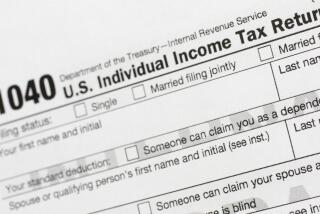Uncle Sam Gives the Lower-Income Taxpayers a Break
- Share via
Nobody likes to pay taxes. But it is particularly tough for those on a tight budget who can’t take advantage of many tax breaks.
Still, there is some good news for lower-income families and individuals about to file their 1990 federal returns: Standard deductions are higher this year, special low-income tax credits are richer and, in the end, you will probably pay slightly less tax if your income is unchanged from a year ago.
Consider our hypothetical taxpayer, Susan Doe. She’s a divorced secretary who earns $19,000 annually and cares for one child. She doesn’t contribute to a tax-favored retirement plan and she has no mortgage interest deductions.
This year, she’ll pay $794 in federal taxes, versus $931 a year ago. That’s down $137--about 14.7%--from 1989, assuming the same income and deductions.
There are two reasons for the reduction. The government is now indexing tax rates and deductions for inflation. And it allowed more people to qualify for more generous low-income tax credits.
The tax credits are particularly significant because they come right off the top of your bill. For example, Doe was able to deduct an extra $300 from her income this year because of hikes in both personal and standard deductions. But that resulted in a year-to-year tax savings of only $45, because deductions merely reduce taxable income. In other words, Doe paid tax on $300 less dollars. At a 15% rate, that cuts $45 off the bill.
Credits, on the other hand, reduce your tax dollar for dollar. And where she would have received a $33 “earned income” tax credit in 1989, that credit was worth $125 in 1990--or $92 more.
Doe also was able to take advantage of the child-care credit. This tax break is available to anyone who must pay for child care to work. It is not generally available to married taxpayers, where only one spouse works, or for those whose income comes from welfare or disability payments rather than employment.
Federal tax credits are also available for blind and elderly taxpayers. And other credits, including some for renters, are also offered to California residents filing state returns.
However, to claim these credits, taxpayers must forgo the simplest federal form--the 1040EZ--and use the somewhat more complex 1040A. Often, they must also file separate “schedules”--the IRS’ word for forms--to determine the credit’s size.
The forms can appear daunting, but don’t be discouraged, experts advise. If you follow the instructions carefully, you should be able to fill out everything yourself. (Those who need assistance and cannot afford to pay a tax preparer can call the IRS at 800-829-1040 for the location of the nearest Volunteer Income Tax Assistance program. These programs are run by tax professionals who will help individuals prepare both federal and state returns for free.)
How do you fill out a 1040A? Let’s run through the mechanics for our hypothetical taxpayer.
The first page of Doe’s 1040A deals with how many exemptions she has and how much money she makes. She receives no alimony and has no interest or dividend income, so her total income is $19,000 in wages. Since she does not contribute to a retirement plan, her “adjusted gross income” is the same.
Her standard deduction as the head of household is $4,750. And personal exemptions total $4,100 (two times $2,050). These reduce her taxable income to $10,150.
She’s in the lowest tax bracket, so she pays roughly 15% on all her income, or $1,519, according to the 1990 tax table. But now she can subtract for tax credits. To determine the child-care credit, she must fill out Schedule 2 to the 1040A. That asks for the name and Social Security number of the child-care provider, as well as information about how much Doe pays for child care annually.
The government gives partial credit for child-care expenses, up to $2,400 per child or $4,800 per family each year. The amount of the credit depends on the taxpayer’s adjusted gross income. In Doe’s case, this amounts to 25% of her total expenses, or $600. (The maximum credit available is 30%, the minimum, 20%.) That reduces her tax to $919, or $1,519 minus $600.
According to the form, that is her “total tax.” But, actually, she will only pay $794. The reason for the disparity? The IRS grants the earned income credit in a back-door fashion. Instead of reducing your tax due, the credit is considered extra money withheld. Still, the result is the same.
She could pay even less if she were able to buy a home and deduct mortgage interest expenses or if she contributed to a tax-favored retirement plan. However, those who earn less than $25,000 annually can rarely afford such tax-planning strategies.
“Somebody with this kind of income is probably living from paycheck to paycheck,” said Darrell Gydesen, assistant district manager at H&R; Block in Los Angeles.
LOWER-INCOME TAXPAYER Susan Doe, a hypothetical taxpayer, is a 35-year-old secretary who earns $19,000 a year. She’s divorced and has one child. Her husband pays some child support but no alimony. She has no home mortgage and does not contribute to a deductible retirement account, so she will take the standard deduction of $4,750 for a head of household in 1990.
Earned income: $19,000 Child support received: 6,000 Interest income: 0 Consumer interest expenses: 300 Medical expenses: 500 Child care expenses: 2,400 Standard deduction: 4,750 Personal exemptions: 4,100* Taxable income: 10,150 Tax: 1,519 Child care tax credit: 600 Earned income tax credit: 125 Final tax paid: 794
* This assumes Doe claims herself and her child as personal exemptions. In some cases, a spouse paying child support would get the deduction instead.
More to Read
Inside the business of entertainment
The Wide Shot brings you news, analysis and insights on everything from streaming wars to production — and what it all means for the future.
You may occasionally receive promotional content from the Los Angeles Times.










